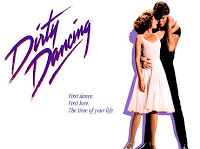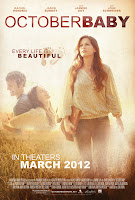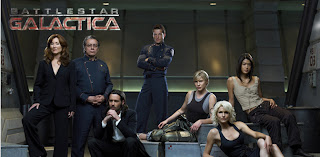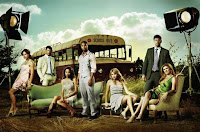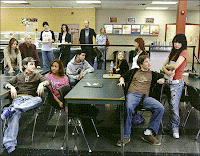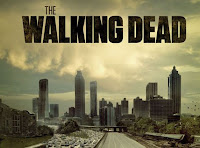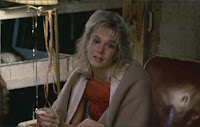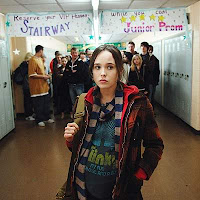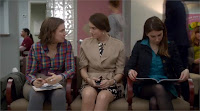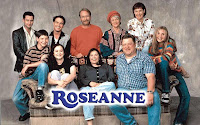Dirty Dancing I was less than a year old when Dirty Dancing came out. It is known for the chemistry between its stars, incredible choreography, and a fantastic soundtrack that balances the sounds of the 60s and the 80s. It’s a typical coming-of-age story, but one of the less-discussed plot points in the film is how it approaches the consequences of an unintended pregnancy during a time in which abortion was still illegal (The film takes place in 1963). As a lifelong fan of the film, Dirty Dancing was my first introduction to the issues of abortion. The film is incredibly progressive in its depiction of Penny Johnson (Cynthia Rhodes), a dancer forced to face the most difficult of decisions, and makes a very strong illustration of the consequences of illegal abortions.
October Baby What October Baby lacks for in quality, it makes up for in heavy handedness. The stiff acting and bland writing would normally just make October Baby a dull movie. But, coupled with ignorance and surprisingly good sales – $1.7 million in its first weekend – it also poses a threat to the narrative around choice by pushing a misleading and deceptive message about abortion.
The protagonist of October Baby is a college-aged woman, Hannah, who realizes she is adopted and the result of a failed late-term abortion. Her doctor speculates that this late-term abortion attempt is the cause of her health problems such as her bad hip and asthma.
Hannah proceeds to go on a trying-to-be-quirky but actually maudlin coming-of-age road trip to find her biological mother.
The cast of Battlestar Galactica The opening credits of each episode of Battlestar Galactica, which aired from 2004 – 2009, set the premise for the plot: “The Cylons were created by man. They evolved. They rebelled. There are many copies. And they have a plan.” During a few episodes later in the series, the plight for humans’ survival is highlighted with the announcement: “The human race. Far from home. Fighting for survival.” Most of the beginning credits also show the population tally, which dwindles after each battle. President Laura Roslin says at the beginning of their journey, “The human race is about to be wiped out. We have 50,000 people left and that’s it. Now, if we are even going to survive as a species, then we need to get the hell out of here and we need to start having babies.”
When a society is thrust into time of struggle and chaos and its existence is threatened, reproductive rights and bodily autonomy are among the first rights to be taken away by those in power. Battlestar Galactica shows us, as good science fiction does, the moral struggles we face now, and what they might look like in the future.There are moral issues at stake throughout the entire series, including the erosion of prisoners’ and laborers’ rights so that others may live more comfortably. The same critical lens is cast on forced birth, forced abortion, eugenics and abortion restrictions.
The cast of Friday Night Lights In many shows, pregnancy is a simplistic and glossed-over story line, a plot device that comes nowhere near to a realistic depiction of a woman’s experience. How many times have you seen a woman in a television show or movie throw up and know: She’s pregnant! Then you see montages, baby bumps, pregnant women behaving like silly pregnant women, birth, happiness. The end.
In five seasons on the air, Friday Night Lights featured at least three characters who had to make difficult choices about pregnancy: Erin, Tami Taylor, and Becky Sproles. (Mindy Collette is another character who struggles with pregnancy in the show.) We’ve published pieces about Friday Night Lights before, but I want to talk about the show’s excellent handling of pregnancy and abortion in regard to these three particular characters.
Peggy, Betty, and Joan of Mad Men It’s not easy being a lady in the working world today. We’re still fighting for equal pay for equal work, freedom from workplace harassment, and the right to decide what grows (or implants itself) in our uteruses. In all honestly, it’s not terribly different from the drama unfolding at Sterling-Cooper-Draper-Pryce every Sunday night, which is exactly the reason my baby boomer mother can’t stand Mad Men: “I lived it,” she says with exasperation, “why would I enjoy watching it over again?”
Do the liberal-arts educated, Anthropologie-clad millenials fawning over Betty Draper Francis’ silk scarfed bouffants see the irony my mom pointed out? As a card (or more accurately, BA) carrying member of the club, I’d like to say that we do. I’d be hard pressed to find a ladyfriend without a reproductive rights war story of her own, from sanctimonious pharmacists offering unprescribed admonitions to early morning drives across state lines to a clinic. While the scarier aspects of Mad Men-era reproductive health (Betty’s twilight sleep birthing experience from season three, for starters) seem like a far-off nightmare to today’s twentysomethings, neo-conservatives’ war on women makes it clear that such arcane threats may not be so distant.
Where Are My Children? by Erik Bondurant
Where Are My Children? (1916) Long before established reproductive rights, including the right to contraception and abortions, were being challenged, there was a long battle to earn these rights in the first place. Half a century before Griswold v. Connecticut would mark a real turning point for reproductive rights, director Lois Weber offered a powerful commentary, inspired by Margaret Sanger, on the morality of contraception in her 1916 silent feature Where Are My Children?
[…]
Like Vera Drake, this film shows class divisions within reproductive services in an environment where those services are illegal, and the cost that can come from illegal abortions. However, unlike Mike Leigh’s film, this film is decidedly anti-abortion, which may be off-putting to some watching it from a modern perspective. Ultimately, the important pro-contraception aspect of the film and the compelling dramatic construction in portraying the heavy moral component to abortion, no matter what one ultimately thinks of abortion, makes Where Are My Children? a must-see film. Lois Weber, one of the first and greatest directors in cinema history, provides a much-needed woman’s voice and eye on the topic.
Alison shopping for the baby in Knocked Up In 2007, two American comedies failed spectacularly in realistically addressing the issue of abortion, while a Romanian drama delivered one of the most stark and honest portrayals of a woman obtaining an illegal abortion.
Juno and Knocked Up were two of the biggest comedy hits of 2007, while 4 Months, 3 Weeks and 2 Days was completely ignored outside of the arthouse circuit. But both comedies not only do an awful job of treating abortion in a realistic manner, they completely ignore the privilege that their characters have, privilege that not only allows them to consider having a safe, legal abortion, but to decide instead to carry the fetus to term. Every decision that their protagonists make is driven by completely unacknowledged privilege, whereas the decisions that the protagonists of 4 Months, 3 Weeks and 2 Days make are greatly influenced by their lack of privilege. By comparing Juno and Knocked Up to the Romanian drama 4 Months, 3 Weeks and 2 Days, we see the enormous, and largely overlooked, impact that privilege has on both the decision to have an abortion and the decision not to.
Degrassi I grew up in Canada (suburban Montreal to be precise) and Degrassi was the show everyone watched. Even if you didn’t catch the episodes in primetime on the Canadian Broadcasting Corporation (or the CBC), they were on after school every afternoon. When Spike got pregnant, I was in grade 5 and all the grade 6 girls came to school with their little “Eggberts.” While I was a little young for the show, I rushed home after school to watch them in the afternoon as I was beginning to see myself as “too old” for the cartoons my younger brother wanted to watch.I realized very quickly however that there would be a number of challenges in writing about these episodes (Spike’s pregnancy in Degrassi Junior High, Erica’s abortion in Degrassi High, and Manny’s abortion in Degrassi: TNG): untangling my emotional connection to the show and dealing with the different history of abortion and reproductive rights in Canada. While a co-production with WGBH (the Boston PBS affiliate), this show was about as Canadian you could get in terms of its look and attitude toward all of the issues dealt with.
Mother and Child by Candice Frederick
Epps & Washington in Mother and Child While many continue to castigate the HBO series, Girls, for its lack of female diversity (with good reason), I’d like to look back at a 2009 film which gave voices to an assortment of female characters, a gem that eloquently showed both the beauty and plight of motherhood in extraordinary fashion.In writer/director Rodrigo García’s Mother and Child, something as complex and precious as motherhood is broken up into a kaleidoscope of elegant vignettes capturing the lives of several mothers—hopeful, expecting and recovering mothers.
Alluring, delicate and simply exquisite to watch, Mother and Child tackles the inspiring and sometimes heartbreaking aspects of motherhood with a range of characters in which every woman, whether or not she’s a parent, can see themselves.
Watch a preview for When Abortion Was Illegal
Melodramatic Clichés and Missed Opportunities: Lori’s Pregnancy in The Walking Dead by Rebecca Cohen
The Walking Dead Season 2 of the AMC zombie drama The Walking Dead features a character, Lori, grappling with the dilemma of an unexpected pregnancy. Complicating matters are the slightly unusual circumstances, including uncertainty about the baby’s paternity, as well as the minor problem of a zombie apocalypse. Lori’s pregnancy presents an exciting opportunity for the show to delve into weighty themes, but instead the writers thoughtlessly squander it in favor of hackneyed baby daddy melodrama.How much more powerful and dramatic would it have been if Lori really wanted to keep the baby, but ultimately had to decide that she couldn’t? Or perhaps the opposite – maybe she could have initially been determined to abort, but decided that it would be better to risk death than give up on her ideals. At the very least there could have been an interesting conversation or two about it.
Dirty Dancing by Meghan Harvey
Penny, after discovering she’s pregnant The film’s screenwriter and producer Eleanor Bergstein was asked by a potential national sponsor (an acne cream company) to remove the abortion storyline from the film out of fear of a backlash and protests. Bergstein told them, “Oh, I’d be so happy to, but as it happens, it’s so into the plot that if I took it out, there’s no reason for Baby to learn to dance. There’s no reason for her to dance with Johnny, to dance at the Sheldrake, to fall in love with him, to make love with him, so the whole plot falls apart, so I can’t do it.” The sponsor pulled out and the abortion stayed in.An abortion to most of us was an icky medical procedure. You went to a doctor and had it done, end of story. I for one was still too young to understand the moral debate or logistics of abortion, just that it was something that happened.
Dirty Dancing opened an entire generation’s eyes to the fact that it had not always been that simple. For the first time we were seeing it described as being done by a man with a “a dirty knife and a folding table.”
Juno in high school When it comes to abortion, Juno is one film all sides of the debate have alternately claimed as their own and picked apart. Screenwriter Diablo Cody managed to earn both points and critics across the political spectrum with her story of a sarcastic, scrappy, pregnant high school student who, after an ill-fated visit to a creepy clinic ends up deciding on adoption, choosing adoptive parents and advocating for closed adoption, giving birth, and blissfully walking away.Anti-choice activist Jill Stanek declares Juno “the movie pro-aborts will hate,” describing the film’s scene at the abortion “mill” as “hysterical” and the protestor outside the clinic as a “friendly” student with whom Juno engages in “civil conversation.”In contrast, there are those who argue that by virtue of the film being about Juno’s decision, it is inherently in favor of choice. Pro-choice writer Emily Douglas writes that she enjoys the way Juno normalizes teen sexual activity and, while still describing it as a “suburban fairy tale,” also suggests that “It’s a film for the people who love the many imperfect ways families take shape and people grow up.”
American Horror Story Demonizes Abortion and Suffers from the Mystical Pregnancy Trope by Megan Kearns
American Horror Story American Horror Story co-creators Ryan Murphy and Brad Falchuk wanted to create a TV series that truly scared people. And they’ve definitely succeeded in their goal. But why the hell are they so afraid of abortion and women’s reproduction?
According to American Horror Story, we shouldn’t just be terrorized by pregnancy. All aspects of reproduction should scare the shit out of us, including abortion.In the title sequence for each episode, we see jars of aborted fetuses on the shelves in the basement –again fueling the fire of fear and disgust surrounding abortion. It feels like the messages implied here are “good” women don’t get abortions and abortions are gross and scary. Don’t believe me? Trust me, it gets reinforced over and over again. In fact, because of the macabre show’s obsession with abortion, Feminist Film renames it “American Abortion Story.”
Watch Silenced: A Short Silent Film about Clinic Escorts
Grey’s Anatomy Advocates Abortion and Reproductive Rights by Megan Kearns
Oh stars on Grey’s Anatomy Abortion is healthcare — a routine, normal and legal medical procedure. Yet most films and TV don’t ever broach the subject. Their characters don’t get abortions, people don’t talk about abortion. That’s why I’m thrilled about Christina Yang’s abortion storyline on Grey’s Anatomy.
As I’ve shared before, I love the hospital drama. Is it melodramatic? Of course. Is it over the top? Absolutely. But Shonda Rhimes has crafted a show with not only a woman at the center, not only an incredibly diverse cast with open auditions for characters, but a female friendship at its core. Surgeons Meredith Grey and Christina Yang transcend best friends. They are each others’ soulmates…and frequently say so, telling each other and others that the other is “their person.”
Grey’s Anatomy doesn’t stigmatize Christina’s abortion. Instead it shows the detriment of not supporting those you love exercise their reproductive rights. Christina knew herself and made a choice. The series conveys how women are so often silenced when they try to assert autonomy over their body…and the stinging pain when people closest to you don’t respect and support your decision.
Girls and Sex and the City Both Handle Abortion with Humor by Megan Kearns
The cast of Girls Vacillating between vitriolic condemnation and laudable praise, Lena Dunham’s Girls has dominated pop culture dialogue. I eagerly anticipated the series premiere. Yes, the show depicts economically privileged characters. Yes, the incredibly white and homogenous cast should be more diverse. And yes, staff writer Lesley Arfin is absolutely a racist asshole who’s bullshit must be called out. All of these rightfully scathing critiques are not only valid but crucial. But a mere 2 episodes in, Girls portrays potentially nuanced female characters with candid dialogue on sex, friendship, aspirations and relationships. And abortion! Huzzah!Many critics compare Girls with Sex and the City. Both HBO series revolve around 4 female friends in NYC who talk openly about sex, career goals and relationships. Dunham herself addresses the parallels. Although she feels SATC portrays aspirational female friendships whereas Girls, which is messier and more awkward (kind of like real-life), depicts nurturing friendships still fraught with “jealousy and anxiety and posturing.” It’s also hard not to compare as both trendy series tackled abortion.
Roseanne‘s Discussion of Abortion Nearly 25 Years Ago Highlights the Current Feminist Backlash by Stephanie Rogers
Roseanne I grew up watching Roseanne. The show first aired in 1988—when I was ten years old—and it ended after 9 seasons, around the time I graduated high school. The fact that the show now appears in reruns on various television stations, during all hours of the day and night, often makes me feel like the Conners have never not been a part of my life. I saw myself (and my family) in that show, and I identified with the characters and their struggles, particularly surrounding financial issues and social status.Roseanne, a television show starring a fat, working-class, unapologetically outspoken matriarch; a television show that effectively dealt with racism, classism, feminism, gay marriage (depicting the very first gay marriage in the history of television); a television show openly addressing sexism and misogyny, and yes—a woman’s right to choose; and finally, a television show that first aired nearly 25 years ago, is a far more progressive television show than anything currently gracing the network airwaves in 2012.Roseanne’s two-episode arc about a woman’s right to choose—which aired in 1994 (almost 20 years ago)—discussed abortion so openly and unapologetically, especially in its acknowledgment of men’s role in the decision-making process (hint: it’s the woman’s decision, always), that it honestly floored me.
